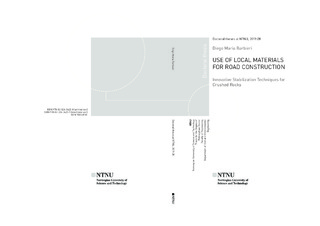| dc.contributor.advisor | Hoff, Inge | |
| dc.contributor.advisor | Uthus, Lillian Mathisen | |
| dc.contributor.author | Barbieri, Diego Maria | |
| dc.date.accessioned | 2019-04-09T08:15:00Z | |
| dc.date.available | 2019-04-09T08:15:00Z | |
| dc.date.issued | 2019 | |
| dc.identifier.issn | 1503-8181 | |
| dc.identifier.uri | http://hdl.handle.net/11250/2593807 | |
| dc.description.abstract | The Norwegian Public Roads Administration is currently running the “Ferry-free coastal route E39” project, which reduces the travel time along the Norwegian highway E39 connecting Trondheim to Kristiansand. The plan includes the creation of several long tunnels, which will generate a surplus of blasted rocks; these unbound granular materials are often damaged from the intensive blasting and will in many cases fail the strict criteria stated in the pavement design guidelines. However, they could be used in the road unbound layers close to the place of production, entailing a sustainable cost-benefit application.
The geology encountered along the E39 road alignment is mapped: several rock types (igneous, sedimentary and metamorphic) are spread in the locations of the tunnelling operations. The existing code defines requirements for road unbound layers in terms of Los Angeles (LA) and micro-Deval (MDE) tests. The major part of the rocks has igneous origin and fulfils the standard check procedures (“strong” rocks); anyway, a considerable quantity of the rocks having different origin does not (“weak” rocks). The materials collected and used for the research mission are characterized by means of thin-section microscopy, X-Ray Diffractometry (XRD), X-Ray Fluorescence (XRF) and Scanning Electron Microscope (SEM). Moreover, the crushability of some different rock types connected to the road construction phase and service life phase is analysed.
The research investigates how to promote the use of the “weak” rocks using some possible techniques in the laboratory. The first approach is the mixture between the various types of rocks available in situ. The second approach is additive application; two different non-traditional additive types are examined: one is polymer-based, the other one is lignin-based. Repeated Triaxial Load Tests (RTLT) are used to assess the additives’ effectiveness. The results are interpreted according to some models available in literature and a finite element model is developed to simulate the repeated triaxial load test and compare its results.
Finally, the research investigates the performance of the additives in the field. Three typical base layer sections are built and added with water (no treatment), water and polymer-based additive, water and lignin-based additive, respectively. The development of the layers’ stiffness and deformation properties are mainly assessed by means of Light Weight Deflectometer (LWD). Dynamic Cone Penetrometer (DCP) and rutting formation evaluation also contribute to investigate the field performance.
The results of laboratory and field test campaigns indicate that both the polymer-based and lignin-based products can enhance the mechanical properties of the “weak” crushed rocks. | nb_NO |
| dc.language.iso | eng | nb_NO |
| dc.publisher | NTNU | nb_NO |
| dc.relation.ispartofseries | Doctoral theses at NTNU;2019:28 | |
| dc.relation.haspart | Paper 1: Barbieri, Diego Maria; Hoff, Inge; Mork, Helge. Laboratory investigation on unbound materials used in a highway with premature damage. Tenth International Conference on the Bearing Capacity of Roads, Railways and Airfields BCRRA 2017; 2017-06-28 - 2017-06-30 | nb_NO |
| dc.relation.haspart | Paper 2:
Barbieri, Diego Maria; Hoff, Inge; Mørk ,Mai Britt Engeness.
Mechanical assessment of crushed rocks derived from tunnelling operations.
The final published version is available in Tunneling in Soft Ground, Ground Conditioning and Modification Techniques
Proceedings of the 5th GeoChina International Conference 2018 – Civil Infrastructures Confronting Severe Weathers and Climate Changes: From Failure to Sustainability, Springer International Publishing
https://doi.org/10.1007/978-3-319-95783-8_19 | nb_NO |
| dc.relation.haspart | Paper 3: Barbieri, Diego Maria; Alex Mofid, Sohrab; Hoff, Inge; Jelle, Bjørn Petter. Nanoscale Technology Enhancement of Crushed Rocks Mechanical Properties for Pavement Application. 6th International Symposium on Nanotechnology in Construction (NICOM6) | nb_NO |
| dc.relation.haspart | Paper 4: Barbieri, Diego Maria; Hoff, Inge; Mørk, Mai Britt Engeness.
Innovative stabilization techniques for weak crushed rocks used in road unbound layers: A laboratory investigation.
- © 2019. This manuscript version is made available under the CC-BY-NC-ND 4.0 license http://creativecommons.org/licenses/by-nc-nd/4.0/
- Final published article in
Transportation Geotechnics 2019 ;Volum 18. s. 132-141
https://doi.org/10.1016/j.trgeo.2018.12.002 | nb_NO |
| dc.relation.haspart | Paper 5:
Barbieri, D.M.; Hoff, I.; Ho, C.S.
Innovative stabilization techniques for weak crushed rocks used in road unbound layers; a lnumerical investigation | nb_NO |
| dc.relation.haspart | Paper VI:
Barbieri, D. M.; Hoff, I.; Mørk, M. B. E.
Innovative stabilization techniques for weak crushed rocks used in road unbound layers; a field investigation | nb_NO |
| dc.title | Use of local materials for road construction - Innovative stabilization techniques for crushed rocks | nb_NO |
| dc.type | Doctoral thesis | nb_NO |
| dc.subject.nsi | VDP::Technology: 500::Environmental engineering: 610 | nb_NO |

